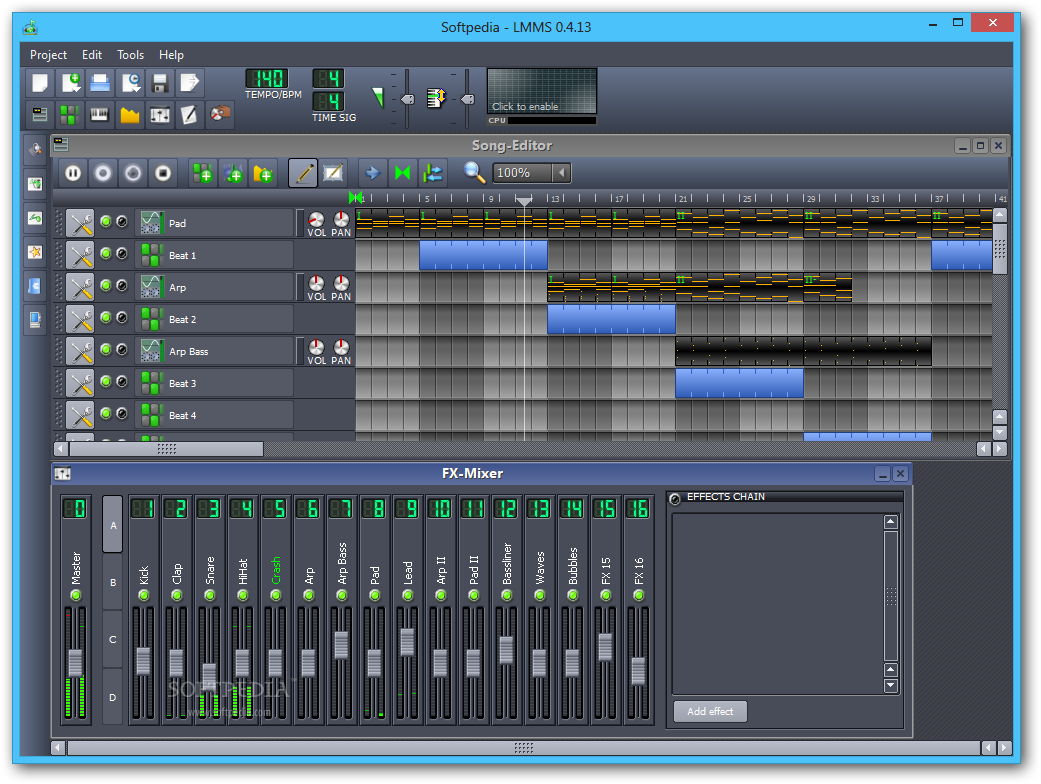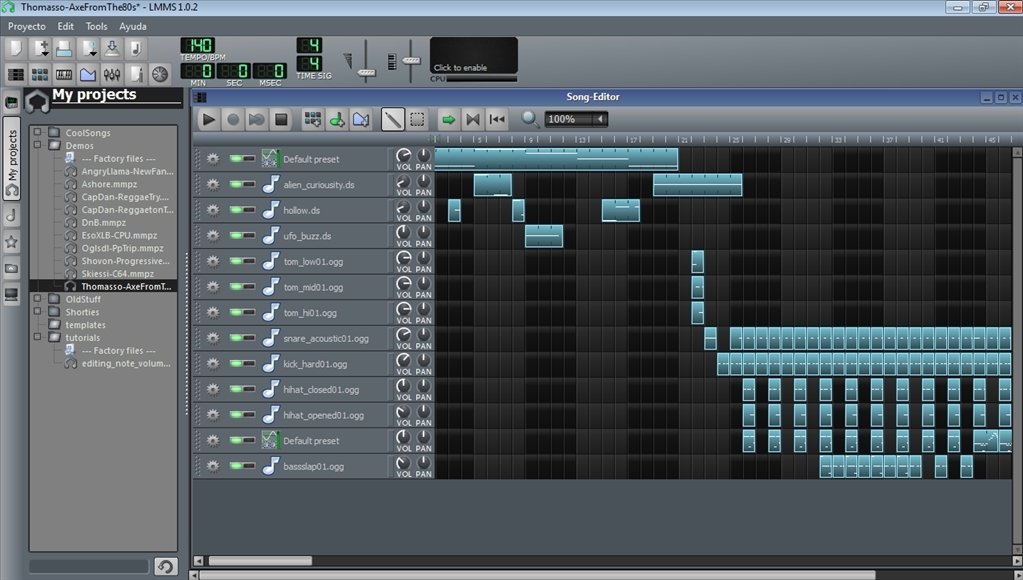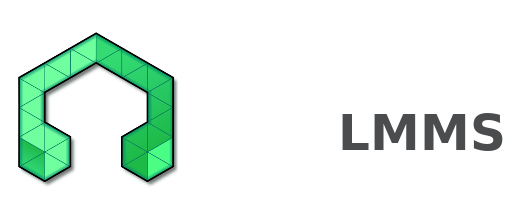Lmms
- LMMS is a free, open source, multiplatform digital audio workstation.
- 301 Moved Permanently.
LMMS Wiki has been archived and it is now read-only. If you are interested in writing documentation or tutorials for LMMS, please move to https://docs.lmms.io/user-manual/.
2021-2022 LMMS Learning Environment Survey. Comments (-1) Interested in Lacrosse? Calling 8th Grade Boys and Girls. Comments (-1) Parent Survey- March 2021.
MIDI settings

You can find the MIDI settings in the Settings window
ALSA-Sequencer is the recommended setting for Linux. WinMM MIDI is the default setting for Windows. Modify the default settings only if necessary.
Quick MIDI setup
This is a quick way of connecting your Instrument to a MIDI device. For more advanced settings go to the MIDI tab.
The MIDI tab
The MIDI tab in the Instrument Editor has some more 'advanced' options.
This guide will hopefully allow you to get acquainted with LMMS and get it linked to your keyboard. Future posts will explain some of the more complex and interesting things possible using LMMS.
Where do I get started?
Let’s get your keyboard up and running, playing an instrument.The first thing you need to remember, is important!
The keyboard should be plugged in BEFORE you start LMMS! If you forget that, LMMS may not find it!
So..
- Make sure your keyboard is connected via USB, and then turn it on!
- Refer to your keyboard’s manual to see if there is an option to change the keyboard to “PC Mode”, where no sound will come from the keyboard itself. If there is no option, turning the keyboard’s volume off should suffice.
- Open LMMS now. This guide presume you use the default settings!
- Look at the “song-editor” window. Since you’ve just opened LMMS, you will have a “TrippleOSC-instrument” in your song-editor! -If not, you use a personalized Template. If so, just drag a TrippleOSC into Song-editor, from My-Instruments in side-bar
- Open the UI, with a click on the preset. TrippleOSC' UI looks somewhat like this:
- Click the word “MIDI” and you’ll go to the MIDI tab.
- Here, click the grayed-out diode, to the left of “enable MIDI input” and the diode should light up green.
- Click the little keyboard icon to the right, on the downward arrow. That opens a list over found and connected MIDI-hardware -Normally its a short-list, but if you have more hardware, it grows..
- Look for your keyboard’s name.
- Select the keyboard with a left-Click.
- Turn your PC speakers on, turn the volume up and play some notes on your keyboard.
You should hear an output now, and the TrippleOSC will default produce a simple sine-wave tone.
If you hear that output; Congratulations!
You’re good to go!
See the next section, on how to get some really realistic instrument sounds and powerful effects.
Deprecated Windows OS
Windows Vista will not let you change MIDI output device (to chose your keyboard). To solve that, you have to make a change in the Windows Registry Editor or install and run programs like VistaMidi.exe from IPE Prodipe VE or Putzlowitschs Vista-MIDIMapper before you can use LMMS.



Let’s get some real sounds working!

First we need a new project, so close all open windows, and then open song-editor (F5) or button 1 in the speedbar.
- In song-editor, Click the blank page icon, in the top left to start a new project.
- In the song-editor window, click on the tools icon next to each track and click “remove this track“. We want a clean and completely blank canvas to work from.
So now we need instruments! The first button in the sidebar opens “instrument plugins” menu.
- Click on it.
- Each of the options is its own instrument plugin which runs inside LMMS, and can be connected up to your keyboard in the same way as above.
- Look at the bottom for “zynAddSubFX“, these plugins are very good, and there are a lot of available highend presets already made for you to enjoy. zynAddSubFX is also called zasfx :) You may also notice there is a plugin for sound samples named Audiofileprocessor, or AFP, as it commonly are called. A SoundFont2 plugin; -You can find many great soundfonts, in the Useful-resources section Useful resources, and many more fine instruments, Like Monster, TrippleOSC, FX-generator -well.. even a Game Boy Color sound plugin called Freeboy ;).
I recommend you to get familiar with all LMMS' instruments, but right now, we will continue with zynAddSubFX.
- Drag zasfx into the song-editor.
It does have a default sound, but that is uninteresting, so lets load a good preset!
- In the sidebar, click on the star. This is the shortcut to your presets!
Browse down to zynAddSubFX, and Choose any you like, I recommend “Arpeggio1″ from the “Arpeggio” category. Some of the guitar sounds are impressive too. But choose any you like. You just drag it out and drop it it on the zasfx instrument! -You can also use right-click and any of the context-options.
- MIDI-Link it to your keyboard with the above steps!
Now you can play around with it for a while. Try different presets, and enjoy.The somewhat complicated methods needed for making your own presets in zasfx, can be studied in the zasfx section of this wiki, and there are also zasfx-tutorials in the video-section.
- I’ll leave it to you to explore what you can to from within zasfx, as it’ll take days and days. You might be impressed now, but the sheer amount of options available is incredible.
- Using the same method shown above, you can try other instrument plugins in the same way.
Connection of a dial to a keyboard-wheel
So now you have sound. Fine!
But then you start thinking about the neat stuff on your keyboard.. Like the modulation-wheel.
How do I connect a specific dial or 'knob' to that wheel?
The basic principle in connecting anything to a keyboard feature is:
- Find the knob you want the Mod Wheel to control (filter freq could be a RL example)
- Right click on the knob and a list will pop up.
- In the list select 'Connect to controller', a 'Connection Settings' box will pop up.
- Make sure MIDI controller and Auto Detect are lit up, then just move the Mod Wheel on your keyboard!
Often it will show as ch1, controller 2
- Click OK and the mod wheel should now control the knob you selected.
you can set up any other knob/slider control on a MIDI keyboard controller the same way. It just sets it up as a different controller (CC) number.
Splitting Keyboards
Some advanced midi-keyboards can split the very kb to more then one instrument
This will in most cases be in need of quite specific operations and setting, but we include one here for Yamaha PSR E443. This does not mean, that this kb is endorsed or recommended at all. This description is solely added to our wiki, as a head-up / bright-idea inspiration, if you are struggling with kb-splitting with your OWN kb!
Specifics for this keybord:
Channels 1 & 2 will work with main voice and dual voice.
Channel is 3 is for a split point - left hand voice.
A combination of any of those can be used. Left hand will not work unless channel 3 is used.
Do the following in the SF2 players:
- Digital Keyboard selected for Midi input and output for all.
- Instrument One – Enable Midi Input – channel 1 – Output channel 1 and program 11.
- Tapped upper keyboard after setting this.
- Instrument 2 – As above this time Channel 2 for input and output and program 6.
- Tapped upper keyboard after setting this.
- Instrument for Right hand – As above with channel 3 for both and again tapped upper keyboard.
- Instrument for Left hand (with keyboard split) – Input selected but with no input channel number. Channel 4 for out put and this time tapped the lower keys after setting.
List of working midi keyboards
Here we list the midi-keyboards, that our users has used successfully with LMMS newer than 1.1.3.The list should not be considered as 'endorsement' of any Brands or manufacturer. You are most welcome to make posts about Your working midi-Hardware on Forum: Add MIDI Hardware
- Akai mpk mini II On Windows (convulated installing -propl. caused by drumpad
- Akai MPD226 on Ubuntu 18.10
- AKAI MPK mini Play On 76 i7 Lemur with Ubuntu Studio 18.10
- AKAI MPK mini Play On Windows 10 Home 1803 (32 bit OS)
- AKAI Professional LPK25 On Windows Vista Home SP2
- AKAI proffesional MPK mini MKII On Windows 10 Home
- Alesis Q49 input device to Q49. OS [NA]
- Arturia Minilab Mk II
- Axiom Air Mini 32 - M-AUDIO On Windows 10 home
- Behringer UMC-204HD USB-Audio device On Ubuntu Linux] 18.04.1 LTS
- Casio CTK6300IN through USB On Windows 10 version 1704
- Casio CTK-591 MIDI to USB adapter Ubuntu 18.04.2 LTS x86_64 4.15.0-50-generic, with JACK
- Casio PX-350M Digital Piano on Win7 Home SP1 & Win10 Home
- Casio Px-860 On win7 Driver update necessary!
- Korg micro keys 25 with Xubuntu 18.04.
- Korg NanoKontrol 2 on Linux.
- Korg Nano's ; Key, Drumpad and Controller. On Win7
- Korg Nanokey2 On Linux Mint
- M-Audio Keystation 61 ES under Kubuntu 10.04
- M_Audio Oxygen 25 MkII on Win7 Home SP1 & Win10 Home
- M-Audio Keystation mini 32 , on Linux and windows.
- M-AUDIO KEYSTATION 49es On Windows 10 Pro 64bit.
- MIDIPLUS AKM320 (32 Mini Size Key USB Midi Keyboard Controller) On Windows 7 Home Premium 64-bit SP 1
- Midistart 3 pro keys' USB keyboard by miditech. On Windows
- Midistart Music 25 Windows 7 & Debian Sid,
- Nektar Impact LX25+ on Ubuntu 18.04
- Novation Launchkey 49 Windows 10, Does NOT work in LINUX-Ubuntu Mate
- Rockband 3 MIDI Keyboard w. MIDISport 1X1, & simple MIDI cable on win10
- Roland Juno-DS88 (Ivory-Like Keys) Windows 10 Pro OEM
- Roland E-300 Intelligent Keyboard - 64 Voice Polyphony w. OIBTECH USB MIDI Cable Interface. Windows 10 Pro version 1903...
- Swissonic easykey49 on ubuntu studio 18.04 64bits OS
- WORLDE Panda Mini controller on windows 10 64bit
- Yamaha DigitalKBD On Windows
- Yamaha DGX-640 Digital 88 Keyboard Yamaha USB-MIDI Driver V3.1.4 for Win 10/8.1/8/7 (64-bit)Windows 10 Home (64-Bit)
- Yamaha E413 keyboard. On WinXP SP3.
- Yamaha E443 keyboard. On Windows.
- Yamaha PSR 500m with MIDI-to-USB On Windows
- Yamaha PSR-E363 On Win10
List last Updated 4. May. 2020
________________________________________________________________
And then one that has been impossible to connect to LMMS:
- SAMSON Graphite M32
Lmms Stable Vs Nightly
Other Working Hardware
Lmms House Plugins
- Akai professional midimix on ubuntu studio 18.04 64bits OS
Navigation
| Prev: Working with VSTs | Up: Manual | Next: Exporting the Song |
Lmms Plugins
